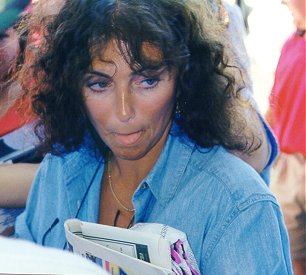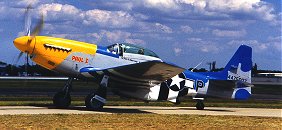Navigate this Site:

 Home
Home

 Racing
Racing

 Nissan Destruction
Nissan Destruction

 Aviation
Aviation


 FAA Database
FAA Database


 Oshkosh Home
Oshkosh Home



 July 26
July 26



 July 27
July 27



 July 28
July 28



 July 29
July 29



 July 30
July 30



 July 31
July 31



 August 1
August 1



 August 2
August 2



 August 3
August 3



 Final Thoughts
Final Thoughts



 Email
Email


 Fort Simpson Trip
Fort Simpson Trip

 MP3 Music
MP3 Music

 Nero's Cancer
Nero's Cancer

 LiveJournal Images
LiveJournal Images

 Treo 650 Software
Treo 650 Software

 Dr. Fun Archive
Dr. Fun Archive

 Freethinkers
Freethinkers
|
Oshkosh
1998: Day 7
Saturday, August 1
We decided that even the terrible breakfast food at Hardees was better than facing oatmeal yet again, so off we went to the Home of Hardened Arteries for breakfast.
The first thing we decided to see was the NASA and Canadian/American buildings that I had toured through the other day, as my father hadn't yet seen them. We had a look at the Customs seizure display again, and also picked up some application forms for the CANPASS and US equivalent - passes which allow general aviation pilots to pass between Canada and the United States with minimal hassle and paperwork from the customs agencies of each country. We actually saw more exhibits at the NASA building than I had seen originally. Two of the exhibits which stick in my mind are a small, solar-powered "Miller Cycle" engine, and a demonstration of microgravity. The engine operates like a two-stroke gasoline engine, except instead of using the heat and pressure of combustion to move the cylinder, it uses the heat generated by the sun, collected by a parabolic dish. The microgravity demonstration was a simple affair of a box with a tiny video camera mounted inside, with various objects placed in front of the camera. The box was then dropped, effectively creating a microgravity environment for half a second or so, while you could observe the actions of the objects on an accompanying video screen. This apparatus was actually designed to be used in schools, and can be constructed from commonly found materials.
Next, we visited the New Piper Aircraft booth. We had wanted to see it sooner, but couldn't find it - it was buried back in the main area, and we had to look at a map to find it. The airplanes they had on display were wonderful - the Seneca in particular. However, they've still got that stupid T-Tail on the Seminole, a light twin that I did most of my multi-engine training on. I asked the Piper guys there why they had put it back into production with the T-Tail, while deleting it from every other airplane. After pestering him enough, I got him to admit that it was mostly because people liked the way it looked, despite the fact it does terrible things to the way the airplane handles.
 We wandered around the remaining
tents near the Piper tents that we hadn't already seen, then headed over to the EAA
pavilion. We caught the end of a speech and question/answer period with Patty Wagstaff.
Afterwards, she came out and signed autographs for a lot of women and young girls - I
think she is a real role model for women who are interested in flying, and she plays the
part perfectly. I couldn't believe how small she is - probably no more than five feet!
We wandered around the remaining
tents near the Piper tents that we hadn't already seen, then headed over to the EAA
pavilion. We caught the end of a speech and question/answer period with Patty Wagstaff.
Afterwards, she came out and signed autographs for a lot of women and young girls - I
think she is a real role model for women who are interested in flying, and she plays the
part perfectly. I couldn't believe how small she is - probably no more than five feet!
 After Patty spoke, the presentation by Chuck Yeager and Bud Anderson which
had been cancelled the previous day was put on. It consisted mostly of Chuck and Bud
telling stories of funny things that had happened to them during the war. Bud told a story
of his and Chuck's last mission as fighter pilots. They were stationed in England, and
knew they only had one mission left. Not wanting to be shot down on their last mission,
they deduced that the safest thing to do would to be to fly over as spares; that way, the
only way they would see action would be if another P-51 in the formation dropped out due
to engine or mechanical trouble. As luck would have it, none of the other airplanes had
problems, so as soon as they crossed the English Channel, Bud and Chuck broke off and
headed up to Switzerland. Chuck had been on a course there recently, and they spent some
time chasing each other up and down mountain slopes. At one point, Chuck radioed to Bud, "hey,
drop your (external fuel) tanks down on that slope there. I'll strafe 'em and we'll see if
we can catch 'em on fire!" Don't forget - this is a neutral country they're
doing this in! After horsing around like this for a couple hours, they headed back across
the Channel and landed at the base. As soon as they landed, a large crowd of people headed
toward them, and Bud thought; "how did they find out so quickly?" Then
he realized they were there because it was their last mission. But he was wrong - as soon
as he got out of the cockpit, he was told, "the squadron just set the record for
most German aircraft shot down - we got 48 of them! How many did you guys get?"
After Patty spoke, the presentation by Chuck Yeager and Bud Anderson which
had been cancelled the previous day was put on. It consisted mostly of Chuck and Bud
telling stories of funny things that had happened to them during the war. Bud told a story
of his and Chuck's last mission as fighter pilots. They were stationed in England, and
knew they only had one mission left. Not wanting to be shot down on their last mission,
they deduced that the safest thing to do would to be to fly over as spares; that way, the
only way they would see action would be if another P-51 in the formation dropped out due
to engine or mechanical trouble. As luck would have it, none of the other airplanes had
problems, so as soon as they crossed the English Channel, Bud and Chuck broke off and
headed up to Switzerland. Chuck had been on a course there recently, and they spent some
time chasing each other up and down mountain slopes. At one point, Chuck radioed to Bud, "hey,
drop your (external fuel) tanks down on that slope there. I'll strafe 'em and we'll see if
we can catch 'em on fire!" Don't forget - this is a neutral country they're
doing this in! After horsing around like this for a couple hours, they headed back across
the Channel and landed at the base. As soon as they landed, a large crowd of people headed
toward them, and Bud thought; "how did they find out so quickly?" Then
he realized they were there because it was their last mission. But he was wrong - as soon
as he got out of the cockpit, he was told, "the squadron just set the record for
most German aircraft shot down - we got 48 of them! How many did you guys get?"
And that is the story of how Chuck Yeager and Bud Anderson missed the single largest air battle of World War II.
After the presentation, we wandered along the homebuilt alley, and I came across Velocity Aircraft. Now I have seen pictures of these airplanes before, and had never given them much thought. In fact, I have never given any homebuilt aircraft much thought at all. However, the Velocity, in particular their XL RG, caught my interest more than any I'd seen before. Looking at that airplane, I started thinking to myself, "hey, I could build this..." I picked up some literature, asked some questions...and started thinking...
In a couple years, perhaps...
 The
British Airways Concorde arrived today, amongst a great fanfare of turbojet noise. They
will be selling short, subsonic rides in Concorde all day Saturday and Sunday for only
$715 a seat!
The
British Airways Concorde arrived today, amongst a great fanfare of turbojet noise. They
will be selling short, subsonic rides in Concorde all day Saturday and Sunday for only
$715 a seat!
 We watched the airshow again, this one had a warbird demonstration again.
They did a particularly effective strafing sequence, where the fighters and bombers would
come in low and pyrotechnics would go off on the ground, simulating a bomb blast. Just for
a fleeting second, I felt something like what it must have been like to be there in World
War II. One of the pyrotechnic explosions set up a large, black, curling smoke ring, and a
Spitfire pilot, seeing this ring, aborted his strafing run and pulled up vertically,
sending his airplane right through the center of the ring. The crowd went wild. We were
also treated to Chuck Yeager flying Paul Poberenzy's P-51. Earlier, they had auctioned off
a ride in a P-51 with Chuck, and it had gone for over $7,500! Chuck said afterwards, "I
don't know who would want to go for a ride in a 55-year-old airplane with a 75-year-old
pilot."
We watched the airshow again, this one had a warbird demonstration again.
They did a particularly effective strafing sequence, where the fighters and bombers would
come in low and pyrotechnics would go off on the ground, simulating a bomb blast. Just for
a fleeting second, I felt something like what it must have been like to be there in World
War II. One of the pyrotechnic explosions set up a large, black, curling smoke ring, and a
Spitfire pilot, seeing this ring, aborted his strafing run and pulled up vertically,
sending his airplane right through the center of the ring. The crowd went wild. We were
also treated to Chuck Yeager flying Paul Poberenzy's P-51. Earlier, they had auctioned off
a ride in a P-51 with Chuck, and it had gone for over $7,500! Chuck said afterwards, "I
don't know who would want to go for a ride in a 55-year-old airplane with a 75-year-old
pilot."
For dinner, we once again headed out to Friar Tuck's, for another excellent, low-cost but high-quality meal. We should have found that place long ago! After dinner we once again watched departing airplanes until the sun went down.
This page copyright � 1998